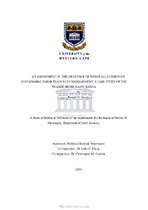| dc.description.abstract | Water problems prevalent in the Nyando River Basin are due to an ineffective water allocation
system and lack of adequate conditions for implementation of sustainable integrated water
resources management (IWRM) strategies. The basin is bedevilled by poor water resources
management, inequitable allocation of water among consumers, physical infrastructural
deficiencies, inefficient water utilisation, illegal water abstractions, natural resource
mismanagement, conflicting and weak institutional roles and lack of stakeholder involvement in
water resource management. The results of the study reveal sufficient per capita annual water
availability with the potential to realise both Sustainable Development Goals (SDGs) and the
Kenyan Vision 2030. However, analyses from flow duration curves (FDCs) and the water
evaluation and planning (WEAP) model show that monthly water demands including environmental
flow requirements (EFRs) are met only between 43% and 94% of the time. While the Water Act
(2002) upholds the principles of IWRM on equitable and sustainable water resources allocation, in
practice the current water allocation system falls short of implementing these strategies due to lack
of a water allocation plan (WAP), inadequate water demand management (WDM), low
infrastructural development and lack of community participation in WRM. For example, the total
revenue generated in water supply schemes is only about 25 to 30% of their operational costs,
which means that in the absence of subsidies the schemes cannot operate. The goal of this study
was to examine the influence of the current water allocation system on water resources management
in the Nyando River Basin by comparing the various sectoral water demands in the basin with the
available water resources in order to improve understanding of how water allocation systems work
in practice. The analyses further revealed that irrigation uses up to 72% of the available water,
which is mainly drawn from the regular low flow contrary to the permit order. For example, the
Ahero National Irrigation Scheme is permitted to draw 47 m3/day of water from regular flow and
13,500 m3/day from flood flow, but draws the whole amount from the regular flow; hence irrigation
is the main cause of water deficits in the basin. Projections show that the irrigation sector will
experience 300% increase in an unmet demand of 92.4 Mm3 by 2030 up from the current annual
deficit of 2.9 Mm3. In light of the above challenges, both improvement of WDM and infrastructural
provision have complementary roles in contributing to sustainable water availability,
socioeconomic growth and poverty eradication in the basin and help achieve SDGs at the local
scale. The results of the study will facilitate an understanding of the influence of water allocation
systems on regional hydrology and form the basis of improving water allocation systems, and
inform policy formulations to ensure sustained water availability and environmental sustainability
in river basins. In that regard, this study contributes to the on-going global debate on Sustainable
Development Goals by exploring ways of realising and improving IWRM strategies and the
National targets. | en_US |

